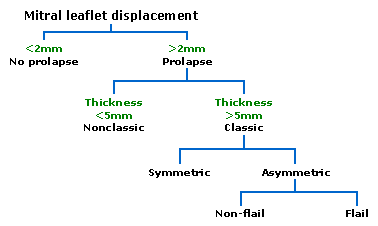Table of Contents
Introduction What Is Mitral-Valve Prolapse? Diagnosis Symptoms Treatment Preventing Complications Clinical Significance
The mitral valve is the heart valve between the left atrium and left ventricle. It has two flaps, called leaflets or cusps, which open and close when the heart contracts (beats) and rests.
Mitral-valve prolapse (MVP) is frequently diagnosed in healthy people and is, for the most part, harmless. Most people suffer no symptoms at all. New estimates are that about 2 percent of the adult population has the condition. MVP is also called floppy valve syndrome, Barlow's or Reid-Barlow's syndrome, ballooning mitral valve, midsystolic-click-late systolic murmur syndrome, or click murmur syndrome. MVP can be present from birth or develop at any age and occurs equally in both men and women. MVP is one of the most frequently made cardiac diagnoses in the United States.
What Is Mitral-Valve Prolapse?
The heart's valves work to maintain the flow of blood in one direction, ensuring proper circulation. The mitral valve controls the flow of blood into the left ventricle. Normally, when the left ventricle contracts, the mitral valve closes and blood flows out of the heart through the aortic valve and into the aorta to start its journey to all other parts of the body.
In MVP, the shape or dimensions of the leaflets of the valve are not ideal; they may be too large and fail to close properly or they balloon out, hence the term "prolapse." When the valve leaflets flap, a clicking sound may be heard. Sometimes the prolapsing of the mitral valve allows a slight flow of blood back into the left atrium. This is called "mitral regurgitation," and may cause a sound called a murmur. Some people with MVP have both a click and a murmur and some have only a click. Many have no unusual heart sounds at all; those who do may have clicks and murmurs that come and go.
Diagnosis
Sometimes, once a physician has heard the characteristic sounds of MVP through a stethoscope, other tests may be ordered. Echocardiography is a common and painless test that uses very high frequency sound waves. The sound waves travel through the layers of the skin and muscle to produce an image of the heart that can be seen on a screen. In this sense, it is similar to radar or sonar imaging.
Initially, "M-mode" echocardiography was used. This technology provides a single-plane view of the mitral valve and often resulted in overdiagnosis of MVP in the 1970s and 1980s. A study from National Heart, Lung, and Blood Institute's (NHLBI) Framingham Heart Study, reported in the July 1, 1999 issue of The New England Journal of Medicine, indicated that MVP is less common and less serious than previously thought.
The investigators used standard echocardiography equipment along with new, more accurate criteria that minimize false positive and false negative diagnoses. Whereas earlier estimates put the number of people with MVP at 5 to 35 percent of the population, the new NHLBI study showed the number is closer to 2 percent. In addition, MVP has long been thought to be more prevalent in women than men but the new study reported the condition appears with similar frequency in both men and women.
In light of this new information, NHLBI suggests that people who were diagnosed with MVP since the 1970s might discuss their current health status with their health care provider to determine if a new diagnostic test is warranted.
Symptoms
The vast majority of people with MVP have no discomfort at all. Most are surprised to learn that their heart is functioning in any way abnormally. Some individuals report mild and common symptoms such as shortness of breath, dizziness, and either "skipping" or "racing" of the heart. More rarely, chest pain is reported. However, these are symptoms that may or may not be related to the MVP.
Treatment
In most cases, no treatment is needed. For a small proportion of individuals with MVP, beta-blockers or other drugs are used to control specific symptoms and some blood pressure lowering drugs may be used to treat mitral regurgitation. Serious problems are rare, can easily be diagnosed and, if necessary, treated surgically.
Preventing Complications
The overwhelming majority of people with MVP are free of symptoms and never develop any noteworthy problems. However, it is important to understand that in some cases mitral regurgitation, the flow of blood back into the left atrium, can occur. Where mitral regurgitation has been diagnosed, there is an increased risk of acquiring bacterial endocarditis, an infection in the lining of the heart. To prevent bacterial endocarditis many physicians and dentists prescribe antibiotics before certain surgical or dental procedures. Patients with significant mitral regurgitation should be followed more closely by their physician so that medical therapy and, if necessary, surgery, can be pursued at the appropriate time.
Clinical Significance
As stated, people with MVP have no symptoms and never develop any notable problems. Whether or not there is any discomfort, however, patients should notify their health care providers of the existence of MVP. This will allow decisions and recommendations to be made about the advisability of using antibiotics to protect against bacterial endocarditis.
For More Information Contact The NHLBI InformationCenter
Telephone: (301) 592-8573 Fax: (301) 592-8563
U.S Department Of Health And Human Services
Public Health Service National Institutes of Health
National Heart, Lung, and Blood Institute
NIH Publication No. 00-865 March 2000
Please send us your feedback, comments, and questions by using the appropriate link on the page, Contact the NHLBI.
Note to users of screen readers and other assistive technologies: please report your problems here.
COPYRIGHT 2000 National Heart, Lung, and Blood Institute
COPYRIGHT 2004 Gale Group



